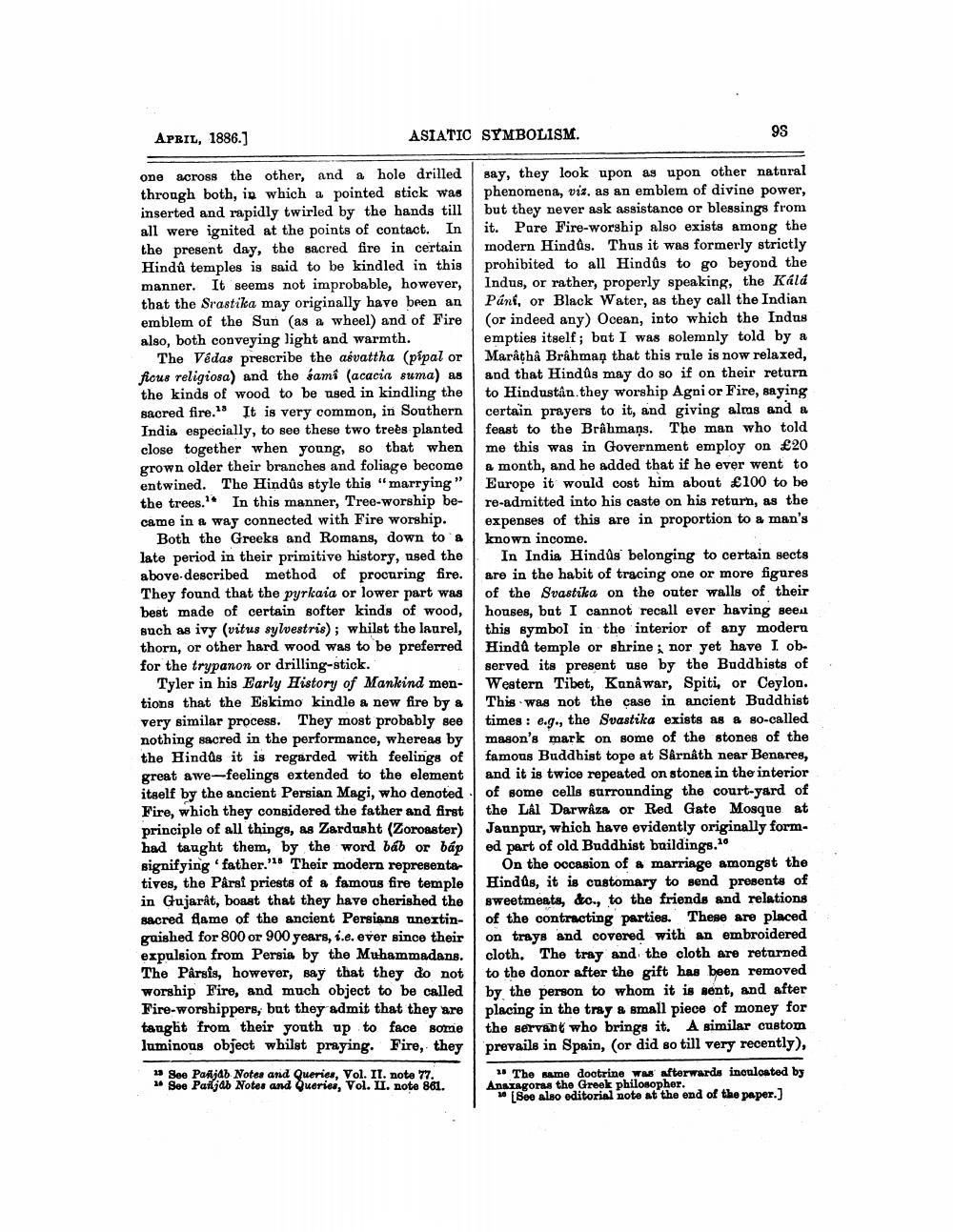________________
APRIL, 1886.]
ASIATIC SYMBOLISM.
9S
one across the other, and a hole drilled through both, in which a pointed stick was inserted and rapidly twirled by the hands till all were ignited at the points of contact. In the present day, the sacred fire in certain Hindu temples is said to be kindled in this manner. It seems not improbable, however, that the Srastika may originally have been an emblem of the Sun (as & wheel) and of Fire also, both conveying light and warmth.
The Vedas prescribe the asvattha (pipal or ficus religiosa) and the sami (acacia suma) as the kinds of wood to be used in kindling the sacred fire. It is very common, in Southern India especially, to see these two trees planted close together when young, so that when grown older their branches and foliage become entwined. The Hindûs style this "marrying " the trees." In this manner, Tree-worship became in a way connected with Fire worship.
Both the Greeks and Romans, down to a late period in their primitive history, used the above described method of procuring fire. They found that the pyrkaia or lower part was best made of certain softer kinds of wood, such as ivy (vitus sylvestris); whilst the laurel, thorn, or other hard wood was to be preferred for the trypanon or drilling-stick.
Tyler in his Early History of Mankind mentions that the Eskimo kindle a new fire by a very similar process. They most probably see nothing sacred in the performance, whereas by the Hindus it is regarded with feelings of great awe-feelings extended to the element itself by the ancient Persian Magi, who denoted Fire, which they considered the father and first principle of all things, as Zardusht (Zoroaster) had taught them, by the word báb or báp signifying 'father."15 Their modern representar tives, the Pârsi priests of a famous fire temple in Gujaråt, boast that they have cherished the sacred flame of the ancient Persians unextinguished for 800 or 900 years, i.e. ever since their expulsion from Persia by the Muhammadans. The Parsis, however, say that they do not worship Fire, and much object to be called Fire-worshippers, but they admit that they are tanglit from their youth up to face some luminous object whilst praying Fire, they
See Pañijdb Notes and Queries, Vol. II. note 77. Soe Pafljab Notes and Queries, Vol. II. note 861.
say, they look upon as upon other natural phenomena, via, as an emblem of divine power, but they never ask assistance or blessings from it. Pare Fire-worship also exists among the modern Hindus. Thus it was formerly strictly prohibited to all Hindûs to go beyond the Indus, or rather, properly speaking, the Kald Páns, or Black Water, as they call the Indian (or indeed any) Ocean, into which the Indus empties itself; but I was solemnly told by a Marâthâ Brâhman that this rule is now relaxed, and that Hindus may do so if on their return to Hindustan they worship Agni or Fire, saying certain prayers to it, and giving alms and a feast to the Brâhmans. The man who told me this was in Government employ on £20 a month, and he added that if he ever went to Europe it would cost him about £100 to be re-admitted into his caste on his return, as the expenses of this are in proportion to a man's known income.
In India Hindús belonging to certain sects are in the habit of tracing one or more figures of the Svastika on the outer walls of their houses, but I cannot recall ever having seen this symbol in the interior of any modern Hinda temple or shrine ; nor yet have I observed its present use by the Buddhists of Western Tibet, Kunwar, Spiti, or Ceylon. This was not the case in ancient Buddhist times : e.g., the Svastika exists as a so-called mason's mark on some of the stones of the famous Buddhist tope at Sârnâth near Benares, and it is twice repeated on stones in the interior of some cells surrounding the court-yard of the Lal DarwÅza or Red Gate Mosque at Jaunpur, which have evidently originally formed part of old Buddhist buildings.
On the occasion of a marriage amongst the Hindus, it is customary to send presents of sweetments, &o., to the friends and relations of the contracting parties. These are placed on trays and covered with an embroidered cloth. The tray and the cloth are returned to the donor after the gift has been removed by the person to whom it is sent, and after placing in the tray a small piece of money for the servant who brings it. A similar custom prevails in Spain, (or did so till very recently),
2. The same dootrine was afterwards inculoated by Anstagoras the Greek philosopher.
Boe also editorial note at the end of the paper.)




